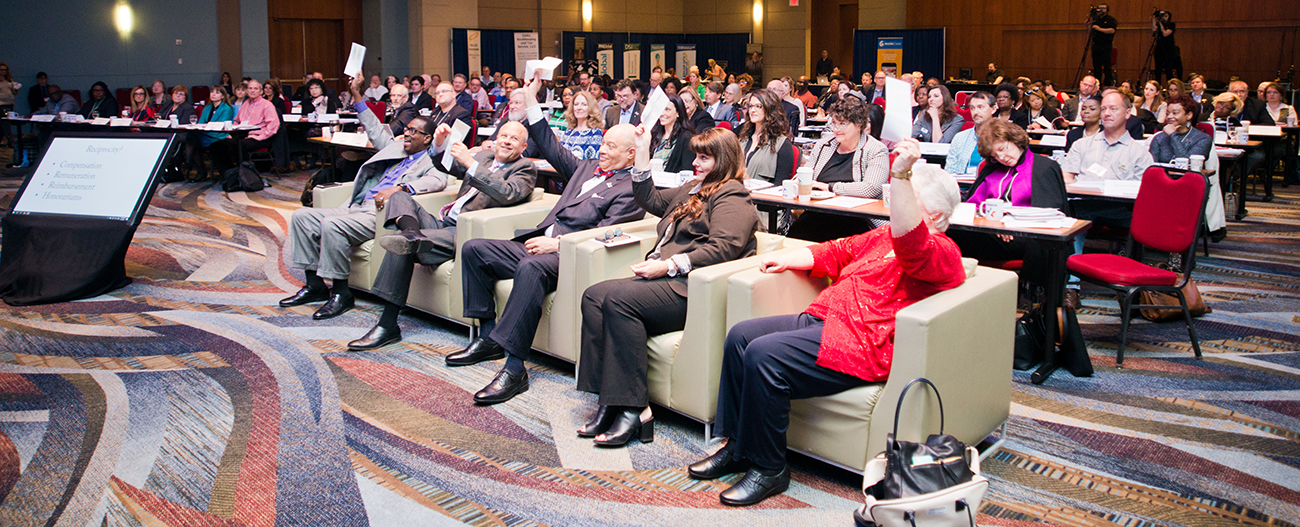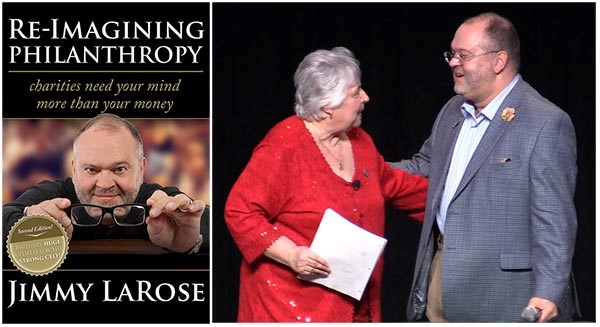
Take a peek above and see an actual photo of NANOE Board Members receiving honorariums for the service to the charitable sector. Are you wondering how much they’re getting? ($300/hour for teleconference meetings [per person]. $1000/day [plus travel expenses] for in person meetings.)
I figured out this whole board thing years ago. It’s kind of simple…
…YOU GET WHAT YOU PAY FOR!
Let me start with what Boardsmanship is not:
-Boardsmanship is not Governance
-Boardsmanship is not Visioning
-Boardsmanship is not Policy-Making
-Boardsmanship is not Volunteerism
VISIT HERE to purchase the book that’s rocking the nonprofit world

Kathleen Robinson & Jimmy LaRose – NANOE Board of Directors
Boardsmanship is not Governance. Don’t kid yourselves. UNPAID VOLUNTEER BOARD MEMBERS DON’T GOVERN. Actual governance occurs when a person (with a full-time salary) supported by various paid staff (the formation of a government) is empowered to perform the daily tasks of decision-making and oversight. Strong CEOs GOVERN!
Boardsmanship is not Visioning. VISION is the way MISSION is achieved and is never the responsibility of the board because the board isn’t being paid to accomplish it. STRONG CEOs DETERMINE VISION. (I’ll agree that board members hold their compensated leader accountable to achieve MISSION.) Here’s what you do. Hire a strong CEO who can be trusted to design a HEROIC VISION OF SCALE that accomplishes mission in ways you never dreamed possible. Believe me, strong CEOs are already doing it their way even if they’re forced to label it “BOARD VISION.”
Boardsmanship is not Policy-Making. Hire a CEO whose depth of experience and formal education has already equipped them as a management expert. The right CEO has been properly trained to oversee the creation of policies that work. Board Members never write policy anyway. Someone else does the heavy-lifting and they rubber stamp it.
Boardsmanship is not Volunteerism. Eliminate the special events committee. Eliminate the fundraising committee. Eliminate the public relations committee. Eliminate the strategic planning committee. (Here’s a good rule of thumb – remove everything from your by-laws that’s not related to IRS compliance.)
Re-assemble these groups as volunteers (non-board members) who serve you directly. For example, a group of social workers is assembled to serve the program director, or a campaign cabinet comprised of community volunteers is built to advance fundraising. You now have individuals in their sweet spots, who are no longer saddled with arcane tasks.
Ok, Like I said, “I’ve figured out this whole BOARD THING!”
Here’s how it works:
Great boards do two things. Here’s what NANOE Board Members provide:
…ADVICE & ACCOUNTABILITY
The STRONG CEO is named chair of the nominations committee and fills these SIX POSITIONS (yes, you only need six [plus]):
1. Business Expert (Chair) Entrepreneur
2. Program Expert (Secretary) Specific
3. Finance Expert (Treasurer) Accountant
4. Legal Expert (Member) Lawyer
5. Communications Expert (Member) PR/Marketer
6. Nonprofit Expert (Member) Consultant
THAT’S IT! (add other experts as needed eg. personnel, etc.) However, don’t forget, working group theory states that any “working group” with more than seven people is no longer a group that works!
Here are their ten clear-cut ADVICE & ACCOUNTABILITY functions:
1. Comply with IRS Regulations
2. Hire strong Chief Executive Officer
3. Approve Meeting Agenda
4. Approve and Amend By-Laws
5. Choose and Review Independent Financial Audit (annual)
6. Choose and Review Independent Program Audit (annual)
7. Evaluate strong Chief Executive Officer
8. Attend Three Meetings per Year with Recorded Minutes
9. Support the CEOs Vision (not the boards vision)
10. Provide CEO their expert advice
There’s your sneak preview! Thanks for taking a moment to set aside the chatter and consider a field-tested and proven “common sense” approach to board management FOR
STRONG CEOs! Take the time to get your own NANOE Board Members. It changes everything!
VISIT HERE to purchase the book that’s rocking the nonprofit world
Warmly,
James P. LaRose, D.P., CNE, CDE, CNC
Board Member
P.S. The group of board members pictured at the beginning of this message was taken at NANOE’s Board of Governors’ Convention and Expo. They are NANOE’s 2017-18 Board of Directors.

2 Comments
Great article and advice. Unfortunately, many nonprofits use their board to fund raise and advocate for their cause. While this isn’t a terrible idea, many times the board becomes inefficient to the point of collapse under the weight of it’s own misdirection. Like you say, the primary role of the board is not to govern or lead but to advice and hold accountable.
[…] Redfern II, Presiding Bishop of the Ecumenical Church of Christ, is the founding Board Chair of the National Association of Nonprofit Organizations & Executives. He has been named by the […]